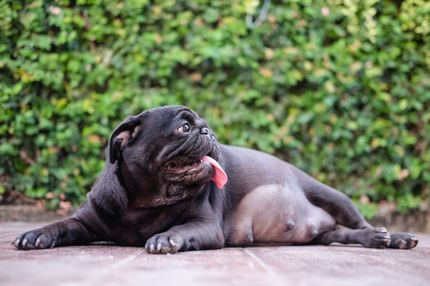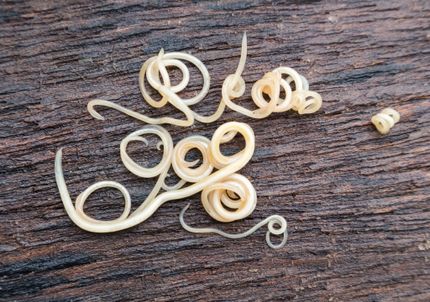Facts & Origin
What is a Smooth Poxer?
The Smooth Poxer, also known as the Smooth Fox Terrier and Pug Mix, is a rare blend of the lively Smooth Fox Terrier and the charming Pug. This hybrid dog combines the best of both breeds and offers a unique blend of temperament, character and appearance.
Origin and history
Regarding its origin and history, there is little documented data due to its rarity. The Smooth Poxer is a designer dog whose creation may have occurred only in the last 20-30 years. However, its parent breeds, the Smooth Pox Terrier and the Pug, both have a long history. The Smoothhaired Fox Terrier originated in England and was originally used for fox hunting, while the Pug originated in China and has a distinguished past as an imperial companion.
| Alternate Name | - |
| Origin | UK - China |
| Life expectancy | 12 - 15 years |
| Care requirements | low-maintenance |
| Activity level | average to high - low |
| FCI group | not recognised |
| AKC group | not recognised |
| KC group | not recognised |
More Smooth Fox Terrier mixes
More Pug mixes
Attitude, character and temperament of the breed
Characteristics and nature
The Smooth Poxer is characterized by his friendly, outgoing personality that is always ready to play. He is known for his loyalty and attachment, which means he prefers to always be by his humans' side. Despite his calmer Pug heritage, the Smooth Poxer also inherits the energetic and adventurous character of his Smooth Fox Terrier parent.
Character and Suitability
An ideal characteristic of the Smooth Poxer is his adaptability. With proper training and socialization, this mixed breed dog can handle almost any lifestyle. His size varies mostly in the medium range, making him attractive to apartment dwellers as well as owners of larger homes.
- Athletic and Active: The Smooth Poxer inherits the energy and enthusiasm of the Smooth Fox Terrier, making regular activity and exercise essential to his health and happiness.
- Friendly and Playful: Smooth Poxers are known for their friendliness and playful nature, which they inherit from the Pug. They love human interaction and are usually very good with children.
- Fastidious Grooming: As the name suggests, the Smooth Poxer has a smooth coat that requires little grooming. However, regular brushing helps to remove loose hair and keep the coat shiny.
Character
Usage
Basic care of the Smooth Poxer
The care of a Smooth Poxer is basically straightforward. Their short, smooth coat only needs a weekly brushing to remove dirt and stay shiny. It is recommended to brush her teeth several times a week to prevent bad breath and dental disease. Check their ears weekly for redness or bad odor, which could indicate an infection.
Health of the Smooth Poxer
Like all mixed breeds, the Smooth Poxer can be prone to the health problems of both parent breeds. These can include respiratory problems, skin problems, and eye conditions. However, the Smooth Poxer is generally considered a healthy breed. Regular vet visits and up-to-date vaccinations help ensure their health.
Breeding a Smooth Poxer
As a mixed breed dog, there are no specific breeding standards for the Smooth Poxer. However, it is important that they come from responsible breeders who put the health and well-being of the dogs first. Make sure both parents are healthy and have good temperaments to ensure your Poxer puppy has the best chance at a long, happy life.
What does this mixed breed look like?
The Smooth Poxer is notable for its remarkable appearance, which reflects a blend of the characteristics of its parent breeds. The build is more like the slender, athletic Smooth Pox Terrier, while the face often exhibits the characteristic features of the Pug, including large, expressive eyes and a flat nose.
The Smooth Poxer's coat is as the name suggests - smooth. It consists of short, dense hair that requires little grooming. Colors vary, with the most common color schemes being black, brown and white. Despite its short hairs, the Smooth Poxer is not suitable for allergy sufferers, as it tends to shed heavily.
Known Diseases
Eye diseases
Often occur with allergies and intolerances.
Ataxia
Ataxia (from Greek ἀταξία ataxia 'disorder' 'irregularity') is a generic term in medicine for various disorders of movement coordination. Ataxia can occur even when there is no paralysis (paresis), that is, when there is normal muscle strength.
Myelopathy
Degenerative myelopathies of dogs are a series of slowly progressing neurological diseases associated with destruction of the spinal cord. These diseases are associated with slowly progressive movement disorders of the hindquarters.
Hip dysplasia (HD)
Hip dysplasia (HD) is a genetic condition in dogs where the hip joint is not shaped properly. This leads to pain, stiffness and restricted movement.
Denture malocclusions
Malocclusions of the dentition often occur in dogs with short muzzles.
Shortness of breath
Difficult breathing can be recognized by the dog's rattling and sometimes accelerated breathing rate.
Overweight
Often, unfortunately, the dogs very much under excess weight. But the dogs themselves are never to blame!
Heart disease
Can occur frequently in dogs and can sometimes be treated with medication.
Breathing problems
Dogs with shortened muzzles can often experience respiratory problems.
FAQ
-
The Smooth Poxer is intelligent, energetic and lively. They enjoy meeting other people and animals. They are very affectionate and would prefer to be with their owner at all times.
-
A Smooth Poxer needs regular exercise and activity. He needs to learn how to behave in different situations.
-
Feeding should always be adapted to the individual dog by paying attention to its age, size and activity level.
-
Yes, Smooth Poxer is very adaptive and will love to learn new tricks. His ingenuity and intelligence make it possible to teach him various tricks and commands.






















